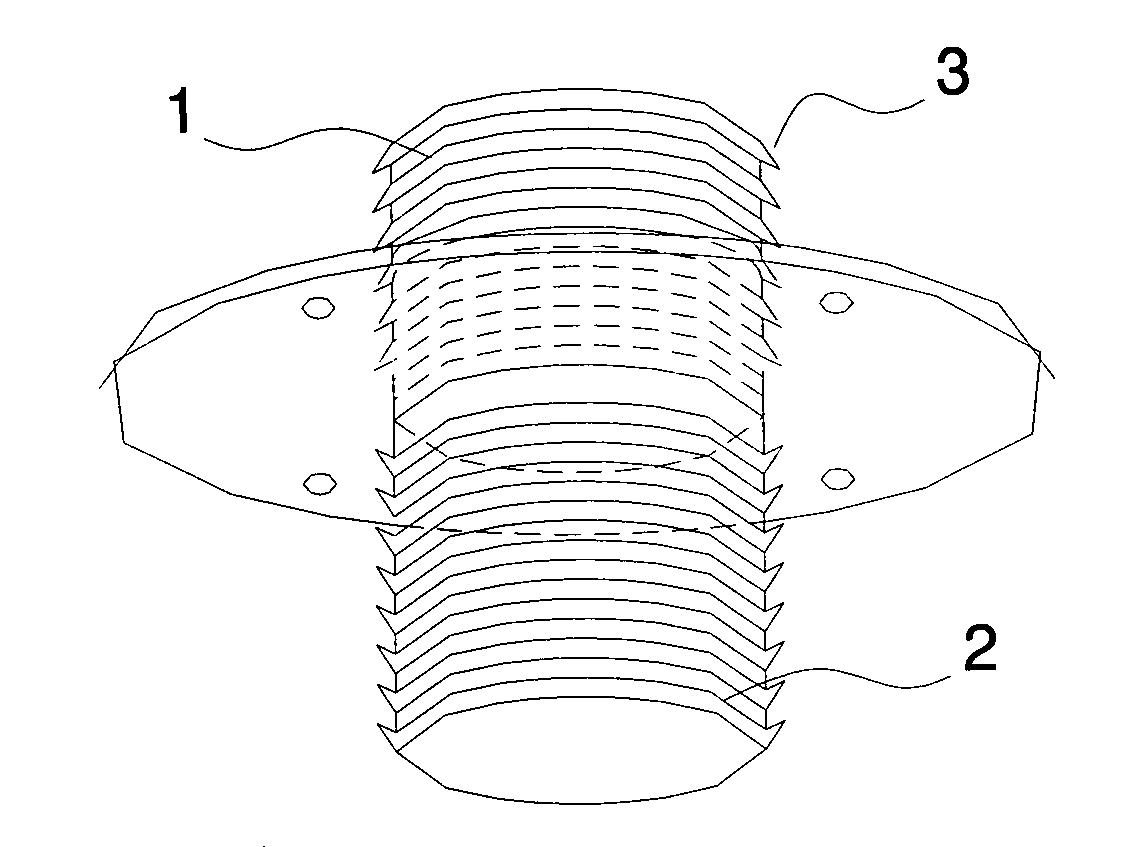Among the disadvantages, there is the fact that it can be used only in extreme cases due to the difficult usage of this technique; it did not obtain a satisfactory result in many surgeries and it is being drowned out of market by the manufacturer; it is not applicable in calcified
aorta; presents suture; presents contact with
blood flow (
foreign body); it does not widen the anastomosis area (restrictive anastomosis); performs only one anastomosis at a time; it is a product
restrict to end-to-side anastomosis; a great mobilization of the
venous graft occurs, damaging it, and can eventually form
thrombus; there is a risk of perforation of the
posterior wall of
aorta; and the
adventitia is removed (most resistant vascular layer).
It is available in only one size, limiting its applicability.
As disadvantages of this prior art, the device has contact with
blood flow (
foreign body); it does not widen the anastomosis area (restrictive anastomosis); it uses veins with external
diameter of 4 to 6 mm and
aorta with an internal
diameter of 18 mm; it does not perform multiple nor visceral anastomosis; it performs just only end-to-side anastomosis; a great mobilization of the used biological graft occurs, damaging its inner layer, which generates the formation of
thrombus; there is a big risk of kinking at the origin (angle of)90° and risk of
posterior wall perforation in the aorta at the moment the device is introduced under its light; the suture is substituted with disadvantages by stainless steel (9 pins, distant among them, maximizing the risk of bleeding).
With this device: it poses a serious risk of bleeding, especially in friable aortas, thin, calcified or fibrous, restricting its applicability, also with risks, even in aortas with normal walls; in small gauge anastomosis, there is a risk of
thrombosis,
hyperplasia,
intimal proliferation and
fibrosis (reaction to
foreign body type in origin of anastomosis) with consequent
stenosis resulting in
occlusion of anastomosis; sutures are used in some cases; there is cases of
infarction caused by equipment; there is a recurring need of re-operations in patients; the device presents contact with
blood flow (foreign body); it is not flexible; it does not multiple anastomosis; an inadequate mobilization of
venous graft occurs, and can cause damage to its intimal layer, it could form
thrombus; it is used only in extreme cases because it is a technique of complex usage; the suture is substituted by stainless steel in contact with blood flow.
There is also an excessive mobilization of graft, and can cause lesions in its intimal layer, which would be the
inductor that forms the thrombus.
The results has not been satisfactory, because it poses risk of bleeding; there is also an excessive mobilization of graft, probably damaging intimal
layers, allowing the formation of thrombus; it is not flexible, by this fact, causes trauma to grafts; it does not make multiple anastomosis, at a single time; presents contact with blood flow (foreign body); and is frequent the need of-operations.
However, initial experimental results demonstrate leakage, also a undesired contact of materials with blood flow.
With this
system, there is also a need of suture in some cases; there is occurrence of
infarction caused by equipment; and is frequent the need of-operations in patients; and also requires clamping.
The use of this method can result in leakages and need traditional sutures; it is frequent the need of re-operation due to leakage / bleeding; and performs only one anastomosis at a time.
Finally, it is also experimentally practiced anastomosis assisted by
laser, where the results are not different from conventional isolated sutures, because there is a need of suture in some cases; there is a risk of bleeding e leakage; and does not perform multiple anastomosis.
Even so divulged nowadays, anastomosis with
damper, by insecurity, and almost totality of surgeons perform conventional sutures throughout the
route of anastomosis, with an intention of avoiding leakages and bleedings, it means the use of clampers just makes the procedure more expensive, once the conventional suture is also applied.
 Login to View More
Login to View More  Login to View More
Login to View More 









